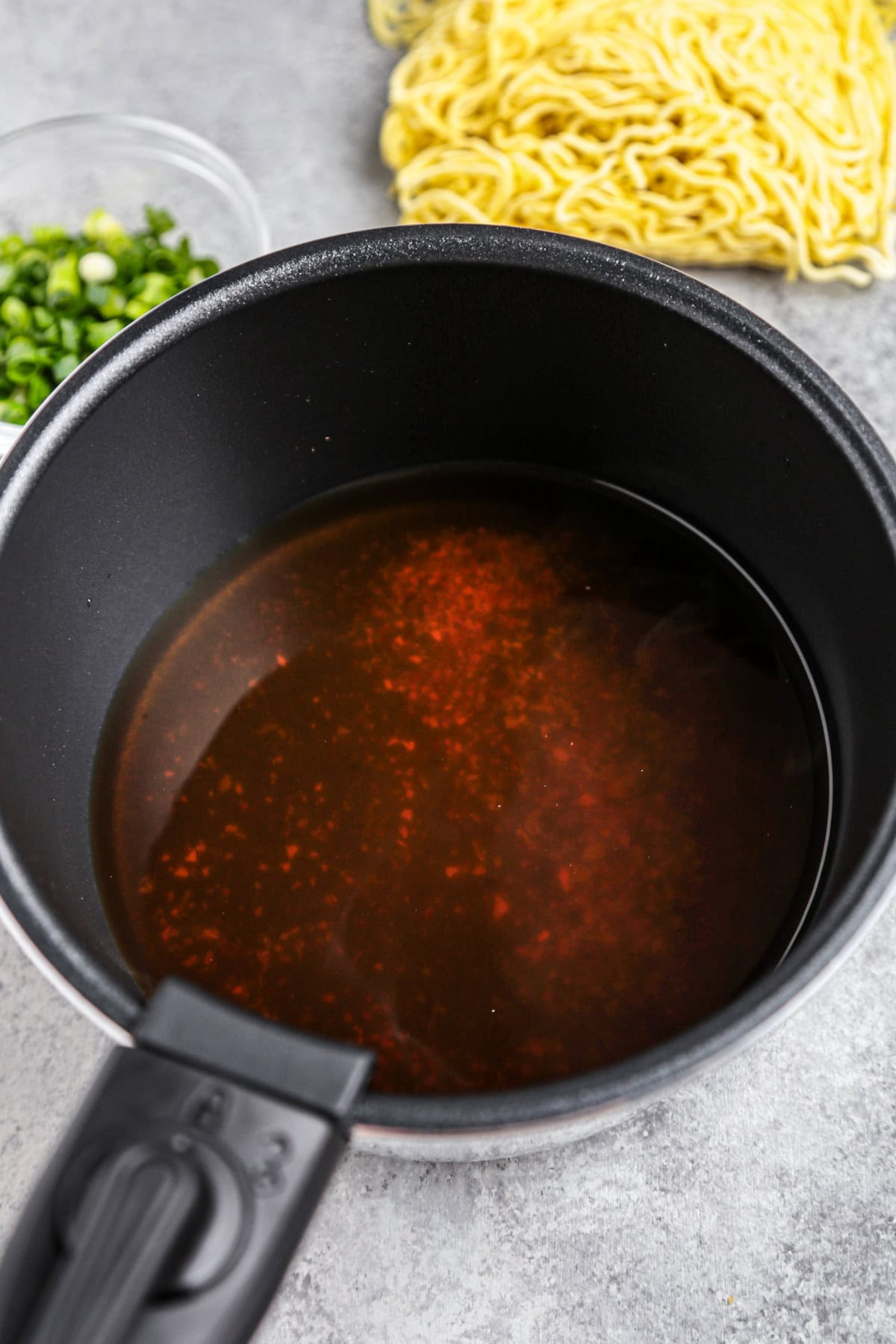When it comes to Japanese dipping noodles, the broth is key. For this tsukemen recipe, I am using a combination of ginger, dashi, chicken stock, soy sauce, and toasted sesame oil, to created a sauce that’s savory, slightly spicy, and nutty. When I’m craving ramen – but want something a little different, this is what I make. Ready in less than 15 minutes from start to finish.

The first time my husband ever visited Tokyo, he was so excited to get out and see everything that we stumbled into a spicy tsukemen shop after a 14 hour flight and no sleep. It was fun to watch as he discovered that tsukemen is a little like ramen – but the cooked noodles are dipped into a concentrated broth served on the side, and then slurped. The idea is that the dipping sauce is thick and strong enough (similar to mentsuyu) that it coats the noodles and provides the perfect amount of flavor, without having to drink the soup.
Why I made this recipe. Now that we live in Tokyo, we’re spoiled for choice when it comes to Japanese dipping noodles. But Ben still craves it all the time. I made this recipe so he’d have a sub-15-minute blueprint for tsukemen he could whip up anytime. The salty, gingery, and nutty dashi turned out too perfect not to share.
Table of Contents

Ingredients
Scroll to the recipe card at the bottom of this page for the full recipe steps and measurements.
- Fresh Ginger: I grate this for a shimmering burn that never quite veers the soup into overtly spicy territory.
- Powdered Dashi and Powdered Chicken Stock: This is my one-two punch of homey savoriness – mixed with the essence of the sea. I use powdered dashi in particular because it’s more powerful than most homemade dashi (which is perfect for this concentrated dipping noodle soup).
- Soy Sauce, Mirin and Water: I use the mellow sweet mirin to balance out the salty umami the soy sauce brings. It’s an iconic Japanese pairing for that exact reason!
- Ramen Noodles: Use fresh ramen or fresh frozen for the best texture. A brick of instant ramen will do in a pinch too.
- Toasted Sesame Oil: I add a tiny bit of sesame oil to each serving of dipping broth right before serving for a rich, toasted nuttiness.
- Sesame Seeds and Green Onions: These soup toppings also go in the small bowls of broth before serving. Since a few will be slurped up each time a new bite of noodles is dipped, I keep a little extra on the table in case I need reinforcements.

Ingredient Variations
Use udon instead. Although Tsukemen is traditionally served with ramen noodles, it works with chewy udon noodles as well.
Add spiciness – or make it milder. For a bit more heat, add Korean gochugaru flakes or Japanese ichimi togarashi. Or just up the amount of grated ginger. For a milder version back off the ginger (or omit it altogether).

How To Make Tsukemen
- Make the broth in a small pot. Bring the liquid ingredients to a boil. Once boiling, turn the heat off and place into small dipping bowls.
- Boil the ramen noodles according the package instructions. Drain and place on serving plates.
- Add toppings to the broth. Scallions, sesame seeds and a little sesame oil.
- Serve immediately.
Expert Tips
Boil the noodles immediately prior serving. Ideally, the noodles should be boiled, drained, portioned and served with as little time in between as possible. That’s for two reasons. First, hot noodles will continue to cook even after draining them. If they sit for a long time, they might get too soft. Second, hot cooked ramen noodles start to stick together fairly quickly, but there’s a solution for that too.
Mix a little sesame oil into the cooked noodles to keep them from sticking together. Just a touch will do. Do this after draining – only if they won’t be served immediately.
Taste the broth – and adjust if needed. This broth isn’t meant to be downed by the spoonful. A quick dip is all the noodles get. So it’s strong by design. If it’s too strong, add a little water. It you like it stronger, add more shoyu or powdered dashi.

Kata-men means ‘firm noodles’ in Japanese. That’s the way I prefer my ramen. Consider it the Japanese equivalent of al-dente in Italian.
Storage and Reheating
Leftover tsukemen can be kept in the refrigerator for up to 4 days, as long as the noodles and dipping broth are stored in separate containers. If the noodles are stored with the ginger tsuyu, they’ll become oversaturated and will deteriorate quickly.
Reheat separately in the microwave. I’m actually not a big fan of leftover noodles. So I personally reheat the leftover soup – and boil a fresh batch of noodles when serving leftovers.
The soup can be stored in the freezer for up to 3 months. Thaw frozen soup overnight in the fridge before reheating. Again, I don’t recommend freezing leftover noodles* as the texture will deteriorate.
*Frozen ramen from the grocery store is usually fresh or par-boiled before being frozen. It’s great! But reheating fully cooked then frozen ramen is a whole different (inferior) ballgame.

What I Serve With Tsukemen
My all time favorite side for dipping noodles is a seasoned ramen egg with a jammy yolk. And, although it may seem counterintuitive to eat rice and noodles in the same meal, I’ll never shy away a small side of chahan (fried rice). Believe it or not, tons of Japanese ramen restaurants have that exact teishoku (lunch set) on their menu. Here are a few of my favorite plug and play Japanese sides:
- Kani Salad – Japanese Imitation Crab Salad
- Japanese Coleslaw (Kyabetsu Salad)
- Goma-ae (Japanese Spinach Salad With Sesame Sauce)
- Green Salad With Japanese Carrot Ginger Dressing
- Shira-ae (Japanese Mashed Tofu Salad)
And check out these umami loaded Japanese recipes: miso soup, ochazuke, tuna mayo onigiri, spicy miso ramen, chukadon, nasu dengaku, shoyu ramen, furikake, omurice, Japanese curry, vegan gyudon, tempeh katsu sandwich, tekka don

Frequently Asked Questions
The only remotely spicy ingredient is the fresh ginger – and I’d classify that as more zingy than full-on spicy. As it’s stands I’d consider this a 2 or 3 out of 10 in the spice department. You could always use less ginger – or leave it out altogether. Or try this mild hiyashi chuka instead.
The dipping broth has intense, concentrated flavor because the noodles only pick up flavor in the short time they spend in the dipping bowl. The soup isn’t meant to be downed by the spoonful. But if it’s still too strong, cut it with a bit of water.
My husband falls into this camp too. Add a bit more powdered dashi, a dash of soy sauce and an extra pinch of powdered chicken stock. Adjust until you’ve found your sweet spot.
Did you like this recipe? Are there changes you made that you would like to share? Share your tips and recommendations in the comments section below!
Print
Ginger Dashi Tsukemen
- Prep Time: 10 minutes
- Cook Time: 3 minutes
- Total Time: 13 minutes
- Yield: 2 servings 1x
- Category: Noodles
- Method: Boiling
- Cuisine: Japanese
- Diet: Low Fat
Description
I make a savory, concentrated dashi and use grated ginger for a bit of fire. These Japanese dipping noodles are ready in just 13 minutes from start to finish!
Ingredients
- 1 teaspoon grated ginger
- 1 teaspoon powdered dashi
- 1 teaspoon powdered chicken stock
- 2 teaspoons soy sauce
- 2 teaspoons mirin
- 1 cup water
- 2 packages fresh ramen noodles
- 1 teaspoon toasted sesame oil
- 2 teaspoons sesame seeds
- 2 green onions, finely chopped
Instructions
- Make the broth: In a small pot, add the ginger, dashi stock, chicken stock, soy sauce, mirin, and water. Stir and bring the mixture to a boil. Turn the heat off and set aside.
- Boil the noodles: Fill a pot with water and bring it to a boil. Add the ramen noodles and cook them for 1-2 minutes, or follow the directions on the package. Drain them well and divide them among two serving bowls or plates.
- Add the toppings to the broth: Divide the broth among two dipping bowls and drizzle a little sesame oil. Top with scallions and sesame seeds.
- Serve: Serve the ramen noodles with the dipping bowl on the side.
Notes
Leftover tsukemen can be kept covered in the refrigerator for up to 3 days. Be sure to store the noodles and soup in separate containers.
Nutrition
- Serving Size: 1 serving
- Calories: 368
- Sugar: 3.7g
- Sodium: 201.4mg
- Fat: 8.5g
- Saturated Fat: 1.5g
- Unsaturated Fat: 2.9g
- Trans Fat: 0.1g
- Carbohydrates: 61g
- Fiber: 3.2g
- Protein: 11.3g
- Cholesterol: 65.3mg














